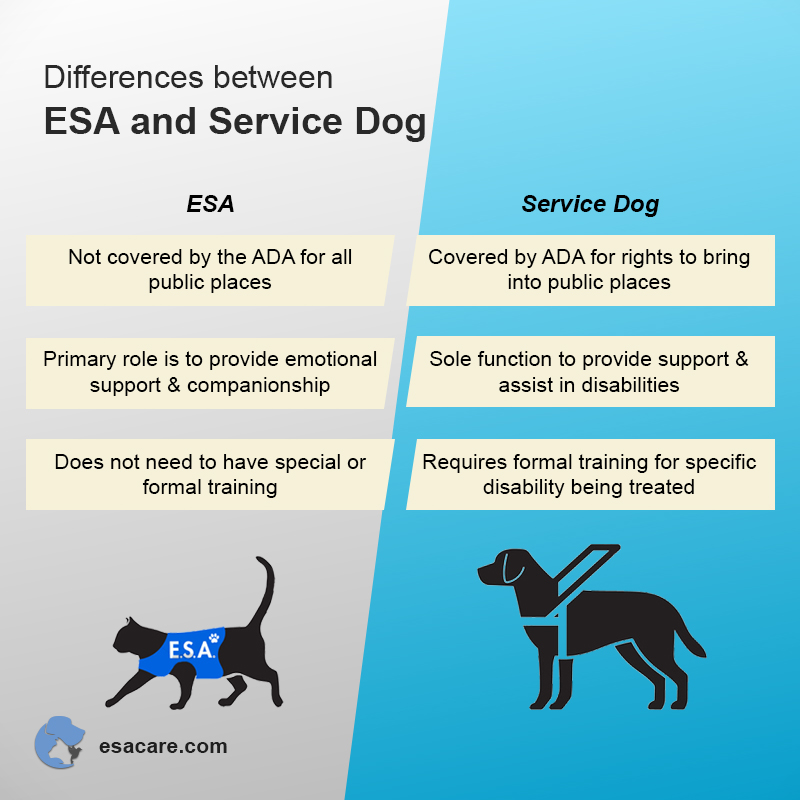Key Takeaways:
-
Rescue pets can become certified emotional support animals (ESAs) with the right training and documentation.
-
Understanding the legal distinctions between ESAs and service dogs is crucial for owners.
-
Proper emotional support dog gear, like training vests, is important for public recognition and accessibility.
-
Professional consultations and legal eBooks are valuable resources for ESA training and certification.
-
Continuous learning and staying informed about legal changes is essential for maintaining ESA certification.
Embrace the Journey: Emotional Support Dog Training With Your Rescue Dog
Transforming a rescue pet into an emotional support dog is a rewarding journey. It not only gives a second chance to a loving animal but also provides invaluable emotional support to those in need. However, it’s a process that requires patience, understanding, and a bit of know-how.

“Teach an Emotional Support Dog” from esacare.com and used with no modifications.
Finding Comfort in Canine Companionship
Emotional support dogs offer more than just companionship; they provide a special kind of healing for individuals with emotional or psychological challenges. By being present, these dogs can help alleviate symptoms of anxiety, depression, and loneliness. It’s not just about having a pet; it’s about nurturing a therapeutic bond.
But how do you start this journey? First, it’s essential to recognize that not all dogs are suited for this role. Your rescue pet needs to have the right temperament—calm, adaptable, and responsive to training. With these traits as a foundation, you’re ready to begin the transformation.
The ABCs of Emotional Support Dog Training
Training an emotional support dog isn’t about teaching them to perform tasks; it’s about reinforcing their natural ability to provide comfort. The training focuses on basic obedience, social skills, and desensitization to various environments.
The Heart of Training: Emotional Support Training Programs
There are many ESA training programs available, but they’re not all created equal. Look for programs that prioritize the well-being of the dog and the needs of the handler. A good program will offer personalized training that respects the unique bond between you and your rescue pet.
From Rescue to Support: Training Steps
Training your rescue dog to be an emotional support animal involves several key steps. Let’s break them down:
Assessing Your Dog’s Personality
Before diving into training, it’s important to understand your dog’s personality. Are they naturally sociable or more reserved? Do they adapt well to new situations? Understanding these traits is crucial for socializing puppy mill survivors and will guide your training approach to help set you both up for success.
Cultivating Calmness and Stability
The hallmark of an effective emotional support dog is their ability to remain calm and stable in various situations. Training should focus on creating a relaxed environment and using techniques that encourage serene behavior.
Positive Reinforcement Techniques
Positive reinforcement is the cornerstone of ESA training. Rewarding your dog for desirable behavior with treats, praise, or playtime encourages them to repeat those behaviors. It’s a method that strengthens your bond and supports their emotional development.
Building Bonds: Socialization and Desensitization
Socialization is key to preparing your dog for their role as an emotional support animal. They need to be comfortable around different people and in diverse settings. Gradually introducing them to new environments and people will build their confidence and your trust in them.
Example: Take your dog to a quiet park initially, then gradually visit busier places as they become more comfortable.
Introducing New Environments
Start by taking your dog to less crowded places and slowly work your way up to busier environments. The goal is to have them remain calm and focused on you despite distractions.
Creating Positive Experiences with Strangers
-
Encourage friends and family to interact with your dog.
-
Offer treats to strangers willing to approach and pet your dog calmly.
-
Praise your dog for maintaining composure around new people.
With each new experience, your dog will learn to associate strangers with positive outcomes, making them better equipped to handle the role of an emotional support animal.
Your Legal Toolkit: Navigating Housing and Travel
As the owner of an emotional support dog, you need to be well-versed in your legal rights. These rights ensure that your companion can reside with you and accompany you during travel, without unnecessary restrictions.
Traveling with Your Emotional Support Dog
While the rules for traveling with emotional support animals have tightened, knowing your rights can help. Airlines may require documentation, such as an ESA letter, so it’s crucial to prepare in advance and understand each airline’s policy.
Mental Health Professional Consultation: Getting Your ESA Letter
An ESA letter is a must-have for any emotional support dog owner. This letter is a formal document written by a licensed mental health professional that states your need for an emotional support animal.
Finding a Licensed Therapist
Finding a therapist who understands the value of an emotional support animal is key. Look for professionals who specialize in animal-assisted therapy or who are open to discussing the benefits of ESAs as part of your treatment plan.
Example: After experiencing heightened anxiety, Sam consulted with a therapist who recognized the calming influence Sam’s dog had on him. The therapist provided an ESA letter which allowed Sam to have his dog in his no-pet housing, significantly easing his daily stress.
The Process and Importance of Official Documentation
Obtaining an ESA letter involves consulting with a licensed mental health professional and discussing your need for an emotional support animal. It’s not just a formality; this letter serves as official documentation that can protect your rights under the Fair Housing Act and during travel.
-
Consult with a licensed mental health professional.
-
Discuss your emotional or mental health needs and how your pet assists you.
-
Obtain an ESA letter that outlines your need for an emotional support animal.
Remember, an ESA letter is different from a service animal certification. ESAs do not have the same public access rights as service animals, but they are afforded certain housing and travel considerations.
Outfitting Your ESA: Emotional Support Dog Gear
Having the right gear for your emotional support dog is about more than just aesthetics. It’s about identifying your dog as an ESA, which can help avoid confusion and ensure that your rights are respected in public and private spaces.
Recognizable Garb: Choosing the Right Training Vest
A training vest is one of the most recognizable pieces of ESA gear. It signals to others that your dog is more than a pet; it’s an essential part of your mental and emotional well-being.
Sizing and Comfort
It’s important to choose a vest that fits your dog comfortably. A poorly fitted vest can cause discomfort or even injury, so take the time to measure your dog and select the appropriate size.
Visible Markings and Identification
Your ESA’s vest should have clear markings that identify it as an emotional support animal. This often includes patches or text that can be easily read from a distance. Additionally, consider an ID tag with your contact information and your dog’s name.
-
Measure your dog to ensure a proper fit.
-
Look for vests with clear “Emotional Support Animal” markings.
-
Attach an ID tag with your dog’s name and your contact details.
While a vest is not a legal requirement, it can simplify interactions with the public and serve as a visual cue of your dog’s important role.
Accessorize and Socialize: Essential Emotional Support Dog Gear
Beyond the vest, there are other items that can support your emotional support dog’s role and well-being.
Collars, Leashes, and ID Tags
A sturdy collar and leash are fundamental for any dog owner, but for an ESA, they also serve as an additional form of identification. ID tags can include information that highlights your dog’s status as an ESA.
Calming Aids and Stimulus Toys
Because your emotional support dog may face stressful situations, consider investing in calming aids such as anxiety wraps or soothing toys. These can help keep your ESA comfortable and focused, enabling them to better perform their role.
Remember, the right gear can make a significant difference in your and your dog’s daily life. It’s not just about complying with legalities; it’s about creating a supportive environment for your emotional support companion.
Expertise on Demand: Professional Consultations for ESA Training
Even with an abundance of resources at your fingertips, sometimes you need the guidance of a professional. Working with a certified trainer can help address specific concerns and ensure that your rescue pet is progressing well in their emotional support training.
Professional trainers can provide personalized plans, troubleshoot challenging behaviors, and give you the confidence to handle your ESA in various situations. They’re particularly helpful if your dog has a troubled past or exhibits signs of anxiety or aggression, which are not uncommon in rescue animals.
Online Training Options
For those who may not have access to in-person training, online options can be a lifesaver. Many reputable trainers offer virtual consultations and training sessions. These can be just as effective, provided you’re committed and can create a conducive learning environment at home.
Educate and Empower: Legal eBooks and Online Resources
Education is power, especially when it comes to understanding the intricacies of emotional support animal laws and training. The internet is a treasure trove of information, but it’s crucial to ensure the resources you use are credible and up-to-date.
Selecting Credible Sources
When looking for information online, check the credentials of the authors and the quality of the institutions backing the resources. Websites affiliated with reputable organizations, such as the American Kennel Club (AKC) or local humane societies, are generally trustworthy.
Self-Learning Through eBooks and Webinars
There are many eBooks and webinars available that can guide you through the process of training and certifying your emotional support dog. These resources often provide step-by-step instructions and valuable insights from experts in the field.
Lifelong Learning: Maintaining Emotional Support Certification
Obtaining an ESA letter and completing initial training is just the beginning. To ensure that your dog continues to serve as an effective emotional support animal, you’ll need to commit to ongoing education and training.
Keeping Up-to-Date on Training and Legal Changes
Laws and regulations surrounding emotional support animals can change. Stay informed about any new legislation that may affect your rights as an ESA owner. Regularly refresh your knowledge and your dog’s training to keep up with best practices.
Re-certification and Continuing Support
While there’s no formal re-certification process for ESAs, it’s a good idea to regularly check in with your mental health professional. They can provide updated ESA letters when needed and support you through any changes in your emotional or mental health needs.
-
Regularly consult with your mental health professional for updated ESA letters.
-
Stay informed about legal changes affecting ESA rights and responsibilities.
-
Continue training and socializing your ESA to maintain their skills and demeanor.
Remember, having an emotional support animal is a commitment that extends beyond initial training. By staying proactive, you can ensure that your ESA remains a positive, healing presence in your life.
Frequently Asked Questions (FAQ)
Here are some common questions about emotional support dogs to help clarify any uncertainties you may have:
What qualifies a rescue pet to become an emotional support dog?
To qualify as an emotional support dog, a rescue pet must be able to provide comfort and support to an individual with an emotional or mental health condition. The pet should have a calm and gentle demeanor and be able to form a strong bond with their owner. A formal recommendation from a licensed mental health professional is also required.
How long does emotional support dog training typically take?
The duration of training can vary greatly depending on the dog’s personality, past experiences, and the owner’s commitment to the training process. Generally, it can take anywhere from a few weeks to several months to train a dog to become a reliable emotional support animal.
Are there any specific breeds that make better emotional support dogs?
While no specific breeds are designated as emotional support dogs, some breeds may naturally possess qualities that make them well-suited for the role. However, any breed can be an emotional support dog if they have the right temperament and training.
Can landlords refuse to accommodate an emotional support dog?
Under the Fair Housing Act, landlords must provide reasonable accommodation for emotional support animals, even in “no pet” housing. However, there are exceptions, such as when the animal poses a direct threat to the health or safety of others or would cause substantial physical damage to the property.
Where can I find reputable emotional support dog training programs?
Reputable training programs can be found through certified trainers, animal behaviorists, or organizations specializing in animal-assisted therapy. It’s important to research and choose a program that adheres to ethical training practices and addresses the specific needs of emotional support animals.


